Sunstone
Also known as "aventurescent feldspar" because some specimens contain light-reflecting inclusions that produce a bright flash.
Author: Hobart M. King, PhD, GIA Graduate Gemologist
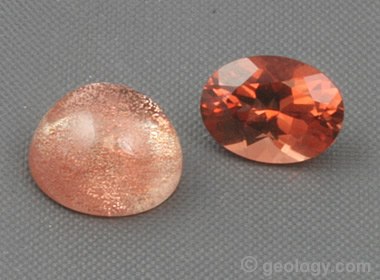
Oregon Sunstone as a faceted stone and a cabochon. The stone on the left is a 7 mm round cabochon with abundant copper platelets weighing 2.29 carats. The stone on the right is a beautiful orange 7x5 mm oval faceted stone weighing 1.01 carats. Both stones are from the Spectrum Sunstone Mine near Plush, Oregon. Both of these materials are known as "Oregon Sunstone".
What is Sunstone?
The name "sunstone" is used for specimens of translucent to transparent feldspar that produce bright metallic flashes when light interacts with tiny plate-like mineral inclusions within the stone. These mineral inclusions usually have a common orientation, and light entering the stone reflects from them at a common angle. This produces a flash of light in the eye of the observer who views them at the proper angle. This optical phenomenon is known as "aventurescence."
The first materials to be called "sunstone" because of their aventurescence were specimens of oligoclase, a plagioclase feldspar. As other types of feldspar with a strong aventurescence were discovered, the name was also applied to them. Labradorite feldspar (another plagioclase) and orthoclase feldspar have both been found with strong aventurescence. [1]
The aventurescent flash of light produced by a sunstone can be observed by three different actions:
 moving the stone in the light moving the stone in the light moving the position of the light moving the position of the light moving the eye of the observer moving the eye of the observer |
Sunstone is also known as "heliolite" and more commonly "aventurescent feldspar." It is cut into cabochons, beads, and small sculptures. The most transparent pieces are used to produce faceted stones.
Sunstone is popular with innovative jewelry designers and is especially popular in the geographic areas where it is commercially mined. It is not a gemstone that is seen in every jewelry store, and many jewelry buyers have never witnessed its aventurescence. However, once a person is given a demonstration of sunstone’s aventurescence, they often want to try it and are fascinated. It is a gemstone that sells best if the jeweler takes a moment to educate the buyer about aventurescence.
Table of Contents
 What is Sunstone? What is Sunstone? Sunstone Localities Sunstone Localities Inclusions that Enhance Desirability? Inclusions that Enhance Desirability? What Color is Sunstone? What Color is Sunstone? Faceted or en Cabochon Faceted or en Cabochon The "Cut" is Everything The "Cut" is Everything History of Sunstone as a Gemstone History of Sunstone as a Gemstone Sunstone Jewelry Sunstone Jewelry |
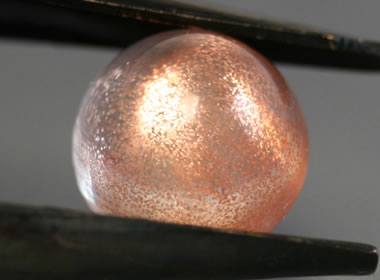
Aventurescent sunstone: Close-up photo of the round sunstone cabochon from the top image, showing beautiful flashes of aventurescence caused by light reflecting from the copper platelet inclusions within the stone.
Sunstone Localities
Aventurescent feldspar has been found in Australia, Canada, China, Congo, Ethiopia, India, Mexico, Norway, Russia, Sri Lanka, Tanzania, the United States (Oregon, New York, Virginia, Pennsylvania) and other localities.
The most famous sunstone deposits in the United States are located in Oregon. A few of the sunstone deposits in Oregon are large enough to sustain mining operations. They are found in certain basalt flows in Lake County and Harney County. There the sunstone occurs as phenocrysts within the basalt. Some sunstone is produced from the weathered zone above the basalt flows, and some is produced from the basalt.
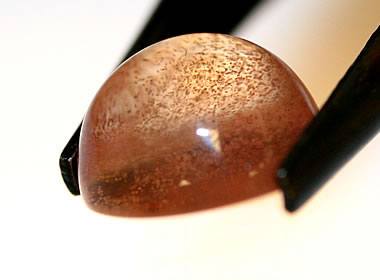
Sunstone with copper inclusions: Close-up photo of the round sunstone cabochon from the top image on this page showing a blizzard of copper platelets inside.
The Oregon basalt flows that contain sunstone are located mainly on public land, and many productive or promising areas are held by mining claims. The U.S. Bureau of Land Management has reserved one area in Lake County as a public collecting area where anyone can enter, look for sunstone, and keep what they find for personal use. Collectors must follow BLM’s collecting rules and stay off of adjacent lands where mining claims have been registered. Collecting on land with an active mining claim can only be done with the owner's permission. [2]
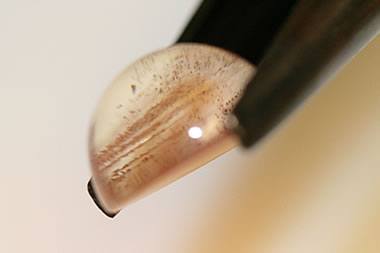
Layered copper inclusions: Close-up photo of the same cabochon as above, from an angle that shows how the copper inclusions are concentrated along planes in the stone.
Inclusions that Enhance Desirability?
Inclusions are particles of foreign material in a gemstone. They cause a reduction in the clarity of the stone and usually decrease its desirability. However, some inclusions in sunstone can enhance the desirability of a gem. These inclusions are flat, plate-shaped, highly reflective, and precisely aligned along a crystallographic axis of their host. This common orientation enables them to simultaneously produce a flash when the stone is moved under incident light. Instead of detracting from the stone's beauty, these flashes of light usually delight the observer and increase the desirability of the stone. The flash can be strong enough to surprise and fascinate the observer.
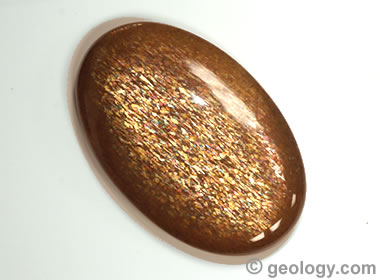
Gold Sheen Sunstone Cabochon: This cabochon was cut from rough mined in Tanzania. This sunstone has very coarse inclusions, some over one millimeter in size. The stone measures approximately 39 x 25 x 6 millimeters and weighs about 54.3 carats.
The inclusions in sunstone are usually tiny plates of copper, hematite, or goethite. They are usually aligned parallel to one of the crystallographic planes within the stone. [1] The inclusions in sunstone can be so small that they are not visible to the unaided eye, or they can be large enough to be clearly visible. The inclusions are extremely thin. Even though they might be large enough to be clearly seen face-on, they are often too thin to be visible when viewed from the side.
Sunstone cabochons with a small number of inclusions produce a weak aventurescent flash. Those with a greater number produce a stronger flash. Some stones have inclusions that are so small that they can't be seen with the unaided eye, but if they are abundant, the color of the inclusions and the reflections from them can impart a distinct color to the gem.
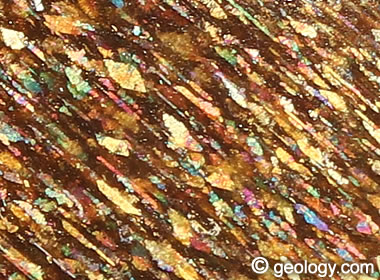
Coarse Hematite Inclusions: This is a close-up of the Gold Sheen Sunstone cabochon shown above. You can easily see the iridescence of the inclusions. The largest inclusions are about one millimeter in size.
The fourth photo on this page (side view of round cabochon) looks into a sunstone cabochon parallel to the inclusion planes. This same cabochon is shown in two of the photos above where it has a distinct reddish copper color. In this photo you can see that the stone appears to be lacking in color - yet this same stone has distinct color when viewed from other angles.
The oval sunstone cabochon in the accompanying pair of photos has extremely coarse inclusions. This cabochon was cut from material found in Tanzania. It has a gold sheen with iridescence caused by very coarse flakes of included hematite - all oriented in a common plane. Some of the inclusions are over a millimeter in size. Please see the accompanying photos.
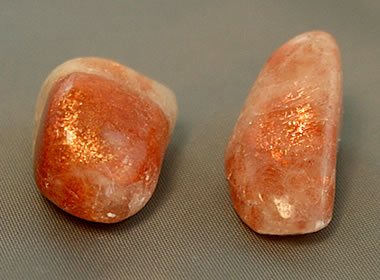
Tumbled sunstone from India that shows flashes of aventurescence. The sunstone from India is thought to have hematite inclusions rather than the copper inclusions of "Oregon Sunstone." If you examine the stones closely with a 10x loupe or a gem microscope, you can tell that they are not copper.
What Color is Sunstone?
Sunstone occurs in a range of colors that begins with colorless and ranges through yellow, orange, and red. The color is determined, in part, by the abundance and size of the copper platelets within the stone. The copper platelets impart a pink or reddish color to the stone. Some exceptional stones are deep green or blue in color.
Color can vary within a single stone. Some stones exhibit a color gradient. They might be pink on one side of the stone and the color gradually strengthens to orange on the other side of the stone. Other stones have sharp color changes. These stones might have patches of green in contact with an area of strong red color. Some exceptional stones are pleochroic - their color depends upon the direction of observation.
The value of gem-quality sunstone is determined by its color, transparency, and the quality of aventurescence. Colorless and yellow stones are usually the least expensive, and values increase through pink, orange, and red. Bright red stones, green stones, and nice bicolor stones have the highest values. Transparent stones with a nice aventurescence command premium prices.
Sunstone can fit almost any budget. Small cabochons with a pleasant orange color and nice aventurescence can be purchased for under $50. Bright red stones and attractive bicolor stones that have been nicely faceted can sell for over $1000 per carat.
Although aventurescence is what has traditionally defined sunstone, clear, gem-quality plagioclase from Oregon without obvious aventurescence has been sold under the name of "Oregon Sunstone." [3] Yellow gem-quality plagioclase without obvious aventurescence from Mexico has been sold under the name "Golden Sunstone." [5]
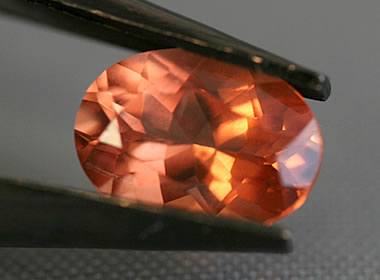
Faceted sunstone: Close-up photo of the oval-shaped faceted sunstone from the top image. The name "Oregon Sunstone" has been used for gem-quality feldspars from Oregon, with and without visible copper platelets or aventurescence. [3]
Faceted or en Cabochon
Most varieties of gemstones that exhibit an optical phenomenon produced by inclusions (such as the asterism displayed by a star sapphire, the chatoyance of chrysoberyl, or the aventurescence of aventurine) are cut en cabochon to best display that phenomenon.
Specimens of sunstone with a nice aventurescence are usually cut en cabochon. Incident light produces a bright glow on a dome-shaped cabochon that is tilted back and forth in the light. When the angle between the observer's eye and the stone is the same as the angle of incident light (but in the opposite direction), the observer sees a bright flash of light. That is when the full reflection from the included platelets is observed.
Transparent "Oregon Sunstone" produces beautiful faceted stones. Faceted sunstone with aventurescence exhibits the beauty of a faceted gem with an optical effect normally seen only in a cabochon.
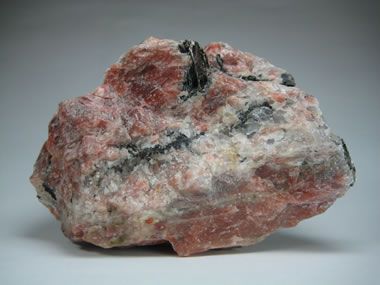
Norway sunstone: A specimen of oligoclase sunstone from Kragero, Norway. This specimen is approximately ten centimeters across.
The "Cut" is Everything
The artisans who cut sunstone must study the stone before they begin work. If the stone is cut at a random orientation, the aventurescence will be less than optimal. The maximum flash and a symmetrical flash in a cabochon is obtained when the stone is cut with the platelets oriented parallel to the top and bottom of the stone. In this orientation the cabochon usually shows maximum color when viewed from directly above, and the aventurescence is symmetrical.
Some artisans use sunstone for small carvings and sculptures. Material up to three inches in size has been found, and some of these large stones are used for carving. Sunstone beads are also popular. As a bead, sunstone displays aventurescence from both sides of the included copper platelets.
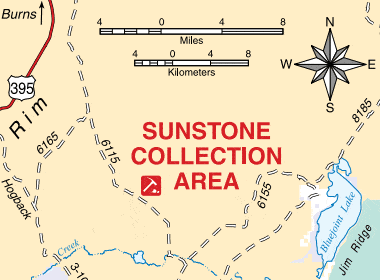
Oregon sunstone collecting: There are a few places where you can go to collect Oregon Sunstone. Here is a list of these "fee mining sites," where anyone can pay a fee and look for gems and minerals.
A free location is the Bureau of Land Management's Oregon Sunstone Public Collection Area. There you can collect sunstone for personal use, but you are not allowed to collect for trade or commercial purposes. (The map above is from the BLM sunstone mining area brochure.)
Fee mining for Oregon Sunstone can be done at the Spectrum Mine and the Dust Devil Mine, both near Plush, Oregon. At these locations you can pay a fee, look for sunstone, and keep what you find.
If you plan to visit any of these locations, be sure to check their websites or contact them in advance to be sure that they are open for visitors, because fee mining is a seasonal activity. To give you the best chance of success, you should also read their website to learn about collecting methods, tools needed, anticipated weather, and nearby lodging or camping. Have fun!
History of Sunstone as a Gemstone
Sunstone has been known for at least a few hundred years. The sunstone deposits of Oregon were discovered by Native Americans who collected the gems, treasured them, traded them widely, and sometimes buried their dead with a small bag of stones.
Sunstone deposits near Lake Baikal in Russia were mined in the early 1800s, and deposits in southern Norway were mined in the late 1800s. Some stones are still produced in these areas. [1]
In the United States the common use of sunstone by lapidaries began in the early 1900s. At that time Tiffany & Company acquired mining claims near the community of Plush, Oregon. There they opened the first commercial sunstone mine in the United States and produced jewelry with faceted sunstone and sunstone cabochons. They called the clear stones "Plush Diamonds." Their efforts with sunstone must not have met Tiffany's expectations because they stopped production and sold their claims. [4]
In the early 1980s, new sunstone deposits capable of sustaining commercial mining operations were discovered in Oregon. This was celebrated in 1987 when the Oregon legislature named "Oregon Sunstone" the official state gemstone. This called attention to sunstone within Oregon and to the lapidary community within the United States.
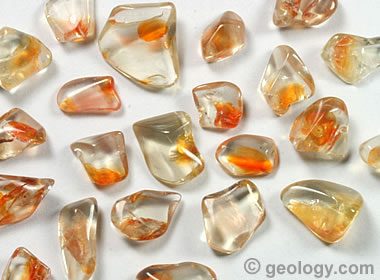
Tumbled Oregon sunstone: A few small specimens of Oregon Sunstone that have been lightly tumbled to facilitate inspection. They contain small, thin clouds of copper particles.
| Sunstone Information |
|
[1] Gems: Their Sources, Descriptions and Identification, Michael O’Donoghue, sixth edition, Elsevier, 873 pages, 2006.
[2] Fee Mining and Digging Sites, A directory of rock and mineral localities where the owners allow visitors to enter and collect for a fee. Resource published on RockTumbler.com. [3] Oregon Sunstones, Ron Geitgey, an article from the February, 1987 issue of Oregon Geology, republished on the Oregon Department of Geology and Mineral Industries website, last accessed August 2022. [4] Sunstone Mining in Oregon, by Alexandra Arch, 1859 Oregon Magazine website, January 2011. [5] Oregon Sunstone, by Marlene A. Prost, Colored Stone Magazine, April - May 2000. |
Sunstone Jewelry
When "Oregon Sunstone" was declared the "state gemstone" by the Oregon Legislature, jewelry designers and lapidaries were inspired to work with sunstone and promote it to Oregon residents and tourists. This created a patronage for a gemstone produced in the United States - especially in the state of Oregon.
"Oregon Sunstone" is now a very popular gemstone in Oregon, where most people have heard of it. Many people who visit Oregon go home with a piece of Oregon Sunstone jewelry, and this spreads the word about sunstone to other areas.
Sunstone is not often seen in jewelry stores in most parts of the world. It is mainly used by innovative jewelry designers and those who enjoy surprising customers with interesting pieces. The small amount of sunstone entering the market as calibrated stones has limited its use in mass-production jewelry.
As a feldspar mineral, sunstone has a hardness of 6 on the Mohs Hardness Scale and perfect cleavage in two directions. This makes it best suited for earrings, brooches, small pendants, and other jewelry items that will not be exposed to rough wear. When used in rings it is best set in bezel, flush, or recessed settings where the stone will be protected from impact.
Quality sunstone is a wonderful gem, but getting people to notice its aventurescence is a marketing challenge. Jewelers who display it in ways that feature its aventurescence or demonstrate it with enthusiasm are often rewarded with sales. It's all about educating the buyer about the gem's greatest asset.
| More Gemstones |
 |
Tourmaline |
 |
Fancy Sapphires |
 |
Diamond |
 |
Canadian Diamond Mines |
 |
Birthstones |
 |
Pictures of Opal |
 |
Fire Agate |
 |
Blue Gemstones |

Find Other Topics on Geology.com:

|

| ||

|

| ||

|

| ||

|

|
